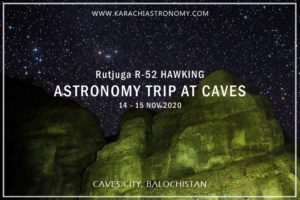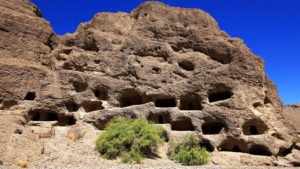Aur keya chaheye..
The Cave City of Pakistan is under one of the darkest skies of the world; around Bortle 1. Imagine, here you are with high-tech telescopes and other astronomical gears. Now being an astronomer, wouldn’t this be in itself a lifetime experience for you. Surely it would be. On top of it, if this very activity is under the guidance and in helping the company of experienced Pakistani amateur astronomers, then participants ko aur keya chaheye (what esle they might want).
Bravo, for more than a decade, Karachi Astronomers Society has been promoting Astro-Tourism in Pakistan. Thereby through these healthy activities, KAS is highlighting globally, worthy events as seen from our lands. Spectra of pursuits of the society are multi-faceted. This range from organizing a variety of astronomical activities; to sharing the observational results of different events with international and local astronomers, societies, and common enthusiasts. Just to get a glimpse of these astounding activities, you can find a repertoire here; when KAS was at Gorakh Hill, ten years back.
Star-night party at the Cave City
This brief blog is just to highlight only one of KAS’s core activities, viz organizing grand “Star-night party” – we call it a Rutjaga (رتجگا) which in simple words is a night-long celebration of astronomy. These are usually held once every month, around moonless nights (اماوس). Favorite sites for KAS’s Rutjagas lie in the dark skies of Baluchistan and Sindh.
Although I have been here with KAS two years back, however, I am jotting this on Nov 14, 2020, right when KAS is all set for camping again at the historical of Baluchistan, the Cave City. This time the Caravan is bigger; 80 plus participants; men and women. Here all adventure filled enthusiasts are off for learning underneath the sky. By the way, this is now a usual group size for KAS outreach events, but these days it moves with SOPs for Covid protections well taken care of.

KAS at the Cave City, Balochistan, promoting Astro-tourism in Pakistan.
The Rutjaga Agenda
While I am writing these words, right now the camping-tents are being erected at the highlands of Cave City. Here, once upon an era, host of Buddhist monks (بدھ بکھشو) used to meditate; aspiring for Nirvana, sitting in their small hundreds and hundreds of man-carved caves. I those times, natural canals used to crawl out of flooding river. Tonight adventurists of KAS, its friends have camped … right there.
Soon within an hour, a lot of celestial observations, presentations, discussions, astrophotography, sessions of informal training, and hands-on experiences would be there. And it would be coupled with on-spot freshly cooked foodies. Hmm, yummy!
Finally, while winter’s another long night has anchored, looped with multiple fun-based, learning activities. I wish all the best to my KAS colleagues and participants. My heart is with you, as I couldn’t join you this time, because of some engagements. O KASians, stay blessed, safe with bright learning under the dark skies.
The Caves & the Cave City
Cave City is also known as Gondrani (گونڈرانی), and yet other names are Mai Peer (مائی پیر), Mai Balochani (مائی بلوچانی) and Shehr-e Roghan (شہرِ روغان). This is an important archaeological site in the District Lasbela, Balochistan. It is about 20 km to the north of the ancient town of Bela, 220 km from Karachi. The way to the city is by and large good, however, some kilometers of the offroad patch is there, with some water patches in between. After all, this is quite enticing for adventurers globally; so it is for Astronomers.
Many historians believe that the town was once a large Buddhist monastery dating back to the eighth century; an era when the region was part of a Buddhist kingdom.

The Cave City, an archaeological site amidst dark skies enticing amateur astronomers.
These caves are locally known as Puraney Ghar (پرانے گھر), are carved into solid rocks. They have multi-levels and are connected by external pathways. All the caves have small rooms with hearths and wall niches for fire lamps, along with front porches. Some even are connected with interlinking tunnels. During British rule, around 1500 caves were counted, but now only 500 remaining, as per the locals. It is claimed that the largest cave has six interconnected rooms, but being on the steep height it not as such accessible.
Like all antiquities, this place too has a lot of myths woven around it. These range from the emancipator lady’s shrine to Prince Saifulmuluk. Some even relate the city with the time of Prophet Suleiman A.S time; means at least 3 millennia back in history. Though interesting stuff but not in the scope of the blogpost so we are not going to drill into it.
Finale
I remember, two years back while visiting the same Cave City, one of our participants told me that she had paid 150 pounds for visiting a similar site in Eastern Europe; she must have. You see, historical sites like these gem-like worthy places deserve extensive research spells by accomplished scholars. This is only possible by persistent patronage by the State of Pakistan and UNO’ss support. If done then this would be a star addition to Unesco’s Listing for Pakistan; because it is certainly an international archaeological heritage.
About the Author
Asim Qadri is an amateur astronomer. To him, it feels like that of his diverse love-domains viz Humans & Poetry, Libraries & Training; all are rooted in Astronomy. By profession, he is a senior Chinese language trainer to the corporate sector and is the founder of Axinstitute for Chinese Language, with Chinese alias Āxìn / 阿信.
Related Vlogs
A good historical and visual account of the city can be enjoyed here in this well-made vlog1 by a YouTube channel Balochistan: Land of Beauty, and vlog2 by Samaa Tv.

